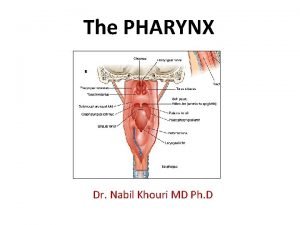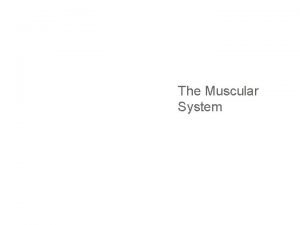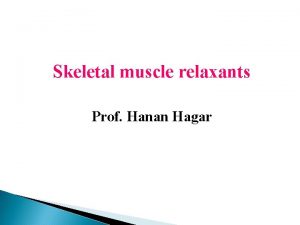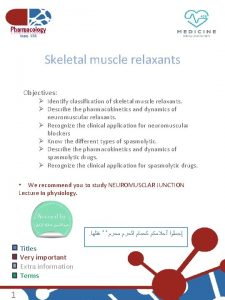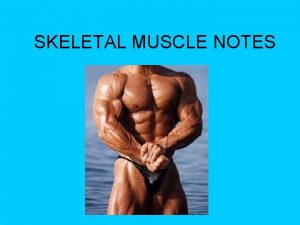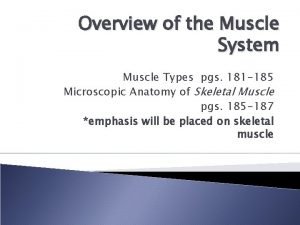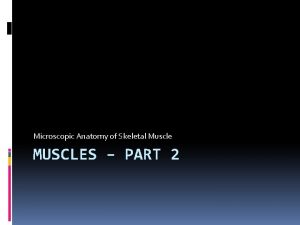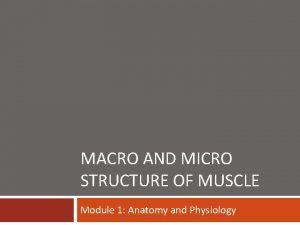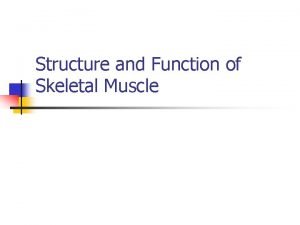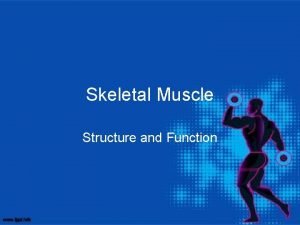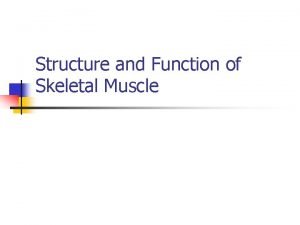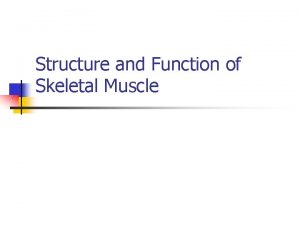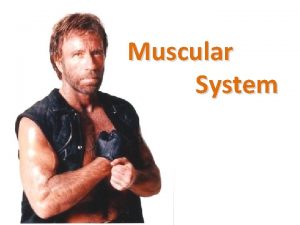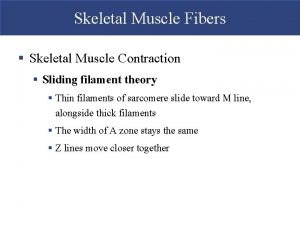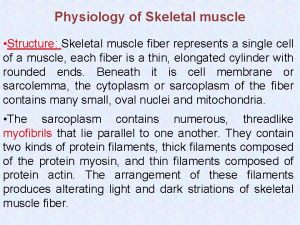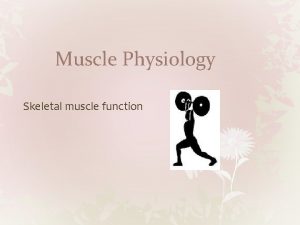Key words Skeletal Muscle Overview of the Muscle













- Slides: 13

Key words: Skeletal Muscle

Overview of the Muscle Fiber Structure • Muscle fibers (cells) are composed of myofibrils • Myofibrils are composed of myofilaments • Myofilaments are composed of a thin filament (contains actin) and thick filament (contains myosin) • The plasma membrane of the muscle cell is called the Sarcolemma

Sarcomere • Sarcomere – One of the segments into which a myofibril is divided, it is the basic unit of contraction of skeletal muscle • Z lines (Z discs) – the boundaries of each sarcomere • Thin (actin) filaments – extend from Z disc toward the center of the sarcomere • Thick (myosin) filaments – located in the center of the sarcomere; overlap inner ends of the thin filaments

Sarcomere • A bands – full length of the thick filament; includes inner end of thin filaments (thus, there is overlap of thin and thick filaments) • H zone – center part of A band where no thin filaments occur (thus, there is no overlap of thin and thick filaments) • I band – region with only thin filaments (thus, there is no overlap of thin and thick filaments) • M line – the center of sarcomere

Thin filament • The thin filaments are composed of the contractile protein called actin plus some regulatory proteins: Troponin and Tropomyosin

Thick Filaments • The thick filaments are made of bundled molecules of the protein myosin, which contains an ATPase region that uses ATP to generate power for muscle contraction

Muscle Contraction • In a relaxed muscle cell, the regulatory protein Tropomyosin prevent myosin binding

Muscle Contraction • Upon stimulation, calcium is released from internal stores and binds to the regulatory protein troponin on the actin filaments • This causes the regulatory proteins to change their shape and position, thus allowing the myosin heads to bind to actin

Muscle Contraction • The physical attachment of myosin to actin causes the myosin heads to snap toward the center of the sarcomere • Since the actin and myosin are still firmly bound to each other when this happens, the thin filaments are slightly pulled toward the center of the sarcomere • This is called the sliding filament theory

The nerve stimulus • Skeletal muscle cells must be stimulated by nerve impulses to contract • One neuron and all the skeletal muscle cells it stimulates are a motor unit

Neuromuscular Junctions • When a nerve cell approaches the muscle it will stimulate, it branches off, forming junctions with the sarcolemma of different muscle cells. These junctions are called Neuromuscular Junctions • Although the nerve endings and the muscle cells are very close, they never touch. The Gap between them is called the synaptic cleft

Activity at the Neuromuscular Junction 1. When the nerve impulse reaches the junction, a neurotransmitter is released. The neurotransmitter specific to skeletal muscles is called acetylcholine 2. Acetylcholine (ACh) diffuses across the synaptic cleft and attaches to receptors on the sarcolemma 3. If there is enough ACh bound to the sarcolemma, the sarcolemma becomes temporarily permeable to sodium ions (Na+); 4. Sodium ions rush into the muscle cell

Activity at the Neuromuscular Junction 5. The inside of the muscle cell becomes positively charged, because it has all the Na+ ions in it 6. The balance of charge is disrupted, and the electrical behavior of the sarcolemma is changed 7. An electrical current is formed, called an action potential 8. The action potential travels over the entire sarcolemma – the result is contraction of the muscle
 Fusiform
Fusiform Layers of pharynx
Layers of pharynx The five golden rules of skeletal muscle activity
The five golden rules of skeletal muscle activity Centrally acting skeletal muscle relaxants
Centrally acting skeletal muscle relaxants Skeletal muscle relaxants classification
Skeletal muscle relaxants classification Skeletal muscle relaxants classification
Skeletal muscle relaxants classification Muscle relaxants classification
Muscle relaxants classification Movable muscle
Movable muscle Comparison of skeletal cardiac and smooth muscle
Comparison of skeletal cardiac and smooth muscle Skeletal muscle relaxants classification
Skeletal muscle relaxants classification Characteristics of skeletal smooth and cardiac muscle
Characteristics of skeletal smooth and cardiac muscle Microscopic anatomy of skeletal muscles
Microscopic anatomy of skeletal muscles Micro and macro structure of skeletal muscle
Micro and macro structure of skeletal muscle Muscle organization
Muscle organization

